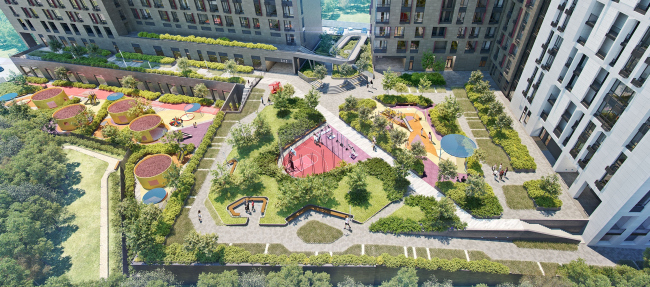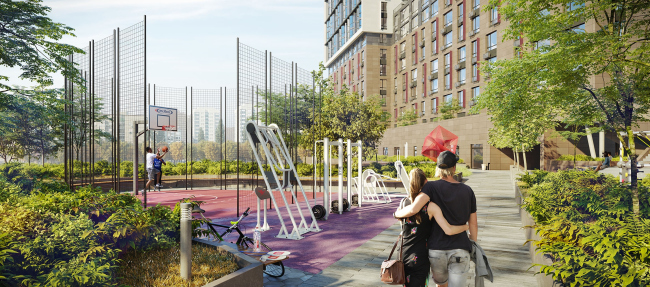|
Published on Archi.ru (https://archi.ru) |
|
| 09.11.2017 | |
|
From Eight to Twenty-Five |
|
|
Julia Tarabarina |
|
| Studio: | |
| Archimatika | |
|
The architecture of Kiev’s housing complex “Time” is based on a combination which is popular nowadays: an eight-story podium plus towers –this volumetric intrigue is enhanced with the play of the components of a multilevel yard. In addition, the apartment plans are thought out really well. "Time" housing complex © ARCHIMATIKAThe residential complex “Time” is being built in the Solomensky district of Kiev – behind the railway station, not far away from the center: it is 5 kilometers or a 15 minutes’ drive away from Kiev’s main Kreshchatik Street. This area has quite a few Stalin-era buildings in it –regular five-stories and palaces with columns as well – but predominantly it consists of postwar city block houses from nine to sixteen stories tall. Currently, amidst this mottled context, taking advantage of the proximity of stores, two parks, a railway station and the city center, different developers are building several housing complexes at once, 25-27 stories high; they form here a new layer of the city that can be termed as the “metropolitan high-rise” one. This scale also refers to the “Time” housing complex, whose construction has already begun on a 0.37-hectare land plot on the Vasilia Lipkovskogo Street. Formerly, this plot was occupied by a two-story bathhouse built back in the 1930’s and a row of garages at its back; on the whole, the plot was clogged up with outlaw construction. At the same time, it is convenient for new housing construction: there is a gym and a supermarket nearby, it takes a fifteen minutes’ walk to reach two of the city’s main parks, and there are a few universities around here as well. Designed by ARKHIMATIKA, this complex consists of two major parts resting on a single podium, each of the two consisting of three sections of different height. According to the architects’ credo, the complex belongs to the “hybrid” typology: its city block corner serves to shield the private vehicle-free landscaped yard situated on the roof of the parking garage, and at the same time it stays open, shooting upwards with four towers – all of this helps to make up for the considerable height of the complex and bring it, by using the space and volumetric techniques, to the following layout: an eight-story city-scale basis plus a higher buildup. "Time" housing complex © ARCHIMATIKAIt should be said at this point that all the marks and levels are by no means arbitrary but are accurately calculated proceeding from the context. The eight- and nine-story houses of the sixties and seventies, situated on the opposite side of the street, have conditioned the first height restriction line: this applies to the corner unit overlooking the street and uniting two towers; the same line of eight-story height can also be traced in the elongated building that stretches into the depth of the yard. The façades of this “basic” contextual level are made of brick, and this is also something that resonates with the surroundings. The tallest towers of the complex are situated at its edges – they are prominently white, 25 stories high each one. In the central part of the L-shaped plan of the complex, there are two “compromise” towers, with brick façades, 23 and 13 stories high respectively. "Time" housing complex © ARCHIMATIKAAnother theme is lighting and views. Here, if one is to gaze southward, the best views are those of the city suburbs, the rivers and streams, and the private houses. If one is to gaze west, it is the Solomenskaya Square and the city beyond it; in the east it is the city center and the Dnipro. These three sides are addressed by the complex with its “television” façades with their French down-to-the-floor windows, and a zigzag surface of triangular bay windows. “According to our plan, the breaks or “creases” of the bay windows on the façade will make a visual contact with pedestrians and drivers – while driving or walking past the complex these angles will deflect, creating a kinetic effect” – shares the cofounder of ARKHIMATIKA Dmitry Vasilyev. The glittering surfaces of the “bellow” bay windows stand out like cantilevers, which turns them – if we are to look from a distance – into a semblance of “periscope” houses watching over the surroundings. The other façades, chiefly brick or white, give the volumes more of a material character and contrast with the glass zigzags, highlighting their glitter. The apartment floor plans deserve a separate passage. ARKHIMATIKA has developed and is using its own standard for high-quality apartments, in which the effectiveness of every square meter is calculated: without any unnecessary partitions or corridors, with minimum pedestrian “runs” inside, the positioning of doors and the length of the walls being optimum for placing the furniture – in a word, the apartments are planned in such a way as to make the most of the floor space that the redirect has paid for, and eliminate any “ballast” square meters. The architects called these apartments “PRO” – and they calculated that these constitute 97% of the housing complex, for the exception of a few apartments that the architects were not able to optimize completely due the necessity to squeeze them into the volumes of the buildings. Probably, everyone will agree that this is a very good percentage of “advanced” apartments. In addition, on the top floors, the architects have designed apartments under pitched roofs with lofts and slanted ceilings – on one of the façades they surface as two-floor ones, and on the opposite façade they surface as single floors – these are penthouses. "Time" housing complex © ARCHIMATIKAYet another version of an exclusive offer is the apartments on the ninth floor of the elongated building that stands in the yard – these apartments boast spacious open-air terraces. Kiev is generally pretty warm, and an open terrace can be used most of the year. However, what attracts attention still more than the multi-tier volumetric composition is the terraced yard situated on the roof of the parking garage. We should note here that the parking garage itself is situated not only underneath the yard but also underneath the driveway that runs along the eastern border of the complex. The two lower tiers of the 13-story building include a kindergarten for 140 children – not only with its own playground on the roof but also with an exit to the zero level. Its appearance was provided for by the requirements for land development; the kindergarten will be open to all the residents of this area – the architects specify. The design of the three-tier yard is rather fun to look at: in the space between two buildings, there is a hanging ramp resting on round metallic supports and a stairway that leads to the second tier and further downwards, to the level of the surrounding streets. Here, in the opening between the houses, some sort of a spacious hub is formed with an overpass, a stairway, and even a skylight that lightens up some of the parking lot. There is also a small park and a small amphitheater here. "Time" housing complex © ARCHIMATIKAPlaces for peaceful recreation are separated from the volleyball field and the children’s playground by manmade knolls, in which the architects are planning to plant not only bushes but also full-size trees. "Time" housing complex © ARCHIMATIKAThe draft ventilation of the underground parking garage – the architects stress – is routed up to the roofs of the top floors, so it will not pollute the air in the yard. Some of the children's playgrounds and sports fields are situated lower, on the zero level, surrounded by a bunch of round gazebos. From the street side, the podium will host shops and restaurants. But then again, quite near, a low-rise yet longish building of the 1930’s hosts a full-scale shipping center. "Time" housing complex © ARCHIMATIKA"Time" housing complex © ARCHIMATIKA"Time" housing complex © ARCHIMATIKAIn a word, the architects took into account most of what makes up a modern housing complex: a highly-developed multilevel podium, whose substructures and overpasses produce an almost “Roman” impression, greenery and quietness of the yard securely separated from the street, apartments of different sizes, including special ones – two-level and ones with the terraces. Plus – modern façades, down-to-the-floor windows, triangular bay windows, and careful calculation of panoramic views. Let alone the geographic location – although in the Soviet part of the city yet still close to the downtown area. All these qualities fall into a rather exciting puzzle which fully meets the requirements of the stipulated housing class and the modern standards of a comfortable city with all of its levels – from the lowest “podium” up to the high-rise one. |
|








